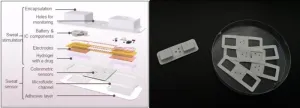(Press-News.org) A new paper in the Quarterly Journal of Economics, published by Oxford University Press, finds that replacing certain judicial decision-making functions with algorithms could improve outcomes for defendants by eliminating some of the systemic biases of judges.
Decision makers make consequential choices based on predictions of unknown outcomes. Judges, in particular, make decisions about whether to grant bail to defendants or how to sentence those convicted. Companies now use machine learning based models increasingly in high-stakes decisions. There are various assumptions about human behavior underlying the deployment of such learning models that play out in product recommendations on Amazon, the spam filtering of email, and predictive texts on one’s phone.
The researchers here developed a statistical test of one such behavioral assumption, whether decision makers make systematic prediction mistakes, and further developed methods for estimating the ways in which their predictions are systematically biased. Analyzing the New York City pretrial system, the research reveals that a substantial portion of judges make systematic prediction mistakes about pretrial misconduct risk given defendant characteristics, including race, age, and prior behavior.
The research here used information from judges in New York City, who are quasi-randomly assigned to cases defined at the assigned courtroom by shift. The study tested whether the release decisions of judges reflect accurate beliefs about the risk of a defendant failing to appear for trial (among other things). The study was based on information on 1,460,462 New York City cases, of which 758,027 cases were subject to a pretrial release decision.
The paper here derived a statistical test for whether a decision maker makes systematic prediction mistakes and provided methods for estimating the ways in which the decision maker’s predictions are systematically biased. By analyzing the pretrial release decisions of judges in New York City, the paper estimates that at least 20% of judges make systematic prediction mistakes about defendant misconduct risk given defendant characteristics. Motivated by this analysis, the researcher here estimated the effects of replacing judges with algorithmic decision rules.
The paper found that decisions of at least 32% of judges in New York City are inconsistent with the actual ability of defendants to post a specified bail amount and real the risk of them failing to appear for trial. The research here indicates that when both defendant race and age are considered the median judge makes systematic prediction mistakes on approximately 30% of defendants assigned to them. When both defendant race and whether the defendant was charged with a felony is considered the median judge makes systematic prediction mistakes on approximately 24% of defendants assigned to them.
While the paper notes that replacing judges with an algorithmic decision rule has ambiguous effects that depend on the policymaker’s objective (is the desired outcome one in which more defendants show up for trial or one in which fewer defendants sit in jail waiting for trial?) it appears that replacing judges with an algorithmic decision rule would lead to up to 20% improvements in trial outcomes, as measured based on the failure to appear rate among released defendants and the pretrial detention rate.
“The effects of replacing human decision makers with algorithms depends on the trade-off between whether the human makes systematic prediction mistakes based on observable information available to the algorithm versus whether the human observes any useful private information,” said the paper’s lead author, Ashesh Rambachan. “The econometric framework in this paper enables empirical researchers to provide direct evidence on these competing forces.”
The paper, “Identifying prediction mistakes in observational data,” is available (on May 28, 2024) at https://academic.oup.com/qje/article-lookup/doi/10.1093/qje/qjae013.
Direct correspondence to:
Ashesh Rambachan
Department of Economics
Massachusetts Institute of Technology
50 Memorial Drive
Cambridge, MA 02142
asheshr@mit.edu
To request a copy of the study, please contact:
Daniel Luzer
daniel.luzer@oup.com
END
Algorithms could help improve judicial decisions
2024-05-28
ELSE PRESS RELEASES FROM THIS DATE:
Scientists uncover a multibillion-year epic written into the chemistry of life
2024-05-28
The origin of life on Earth has long been a mystery that has eluded scientists. A key question is how much of the history of life on Earth is lost to time. It is quite common for a single species to "phase out" using a biochemical reaction, and if this happens across enough species, such reactions could effectively be "forgotten" by life on Earth. But if the history of biochemistry is rife with forgotten reactions, would there be any way to tell? This question inspired researchers from the Earth-Life Science Institute (ELSI) at the Tokyo Institute of Technology, and the California Institute of Technology (CalTech) ...
Monitoring diseases through sweat becomes accessible to everyone
2024-05-28
Sweat contains biomarkers that can monitor various health conditions, from diabetes to genetic disorders. Sweat sampling, unlike blood collection, is preferred by users due to its painless nature. However, to obtain sufficient nutrients or hormones from sweat for testing, intense physical activity was previously required to induce sweat. This method posed challenges for individuals with limited mobility.
Dr. Kim Joohee from the Bionics Research Center at the Korea Institute of Science and Technology (KIST, Director Oh Sangrok) and Professor John A. Rogers from Northwestern University jointly announced the development ...
Mathematical model driven evolutionary therapy dosing exploiting cancer cell plasticity
2024-05-28
Cancer poses significant challenges due to the development of resistance and the likelihood of relapse. Resistance may arise from permanent genetic changes in cancer cells or non-genetic alterations in cancer cell behavior induced by treatment. Standard of care in cancer treatments typically involves administering the maximum tolerated dose of a drug to eradicate drug-sensitive cells effectively. However, this approach often fails in the long term because drug-resistant cancer cells can grow more rapidly when all drug-sensitive cancer ...
Biodiversity in the margins: Merging farmlands affects natural pest control
2024-05-28
A new study published in the Journal of Applied Ecology demonstrates how the diversity and abundance of arthropods decrease when hedgerows and field margins covered by wild grass and flowers are removed.
Researchers from the UK, Netherlands and China studied 20 rice fields in China for six years to see how the changing agricultural landscape affects the diversity and abundance of rice pests and their natural enemies, as well as the effect on rice yield.
Traditional Chinese smallholder fields are irregularly shaped and separated by areas of hedgerows, wild grass, and flowers. Using large-scale machinery in these farmlands is difficult, so there is low agricultural ...
1 in 8 pregnant people have a disability, but significant gaps exist in the provision of accessible care
2024-05-28
Toronto, ON, May 28, 2024 – People with disabilities account for 13% of all pregnancies in Ontario, but a new report shows that this population was more likely to experience pregnancy complications such as emergency department visits, hospitalizations, and preterm birth.
Researchers from ICES, the University of Toronto Scarborough, and the Centre for Addiction and Mental Health (CAMH) have released a landmark report detailing findings from one of the largest studies to date on disability and pregnancy.
Funded by the US National Institutes of Health, the Disability and Pregnancy Study used healthcare ...
Statins associated with decreased risk for CVD and death, even in very old adults
2024-05-27
Embargoed for release until 5:00 p.m. ET on Monday 27 May 2024
Annals of Internal Medicine Tip Sheet
@Annalsofim
Below please find summaries of new articles that will be published in the next issue of Annals of Internal Medicine. The summaries are not intended to substitute for the full articles as a source of information. This information is under strict embargo and by taking it into possession, media representatives are committing to the terms of the embargo not only on their own behalf, but also on behalf of the organization they represent.
----------------------------
1. Statins associated with ...
Climate change is moving tree populations away from the soil fungi that sustain them
2024-05-27
As our planet warms, many species are shifting to different locations as their historical habitats become inhospitable. Trees are no exception – many species’ normal ranges are no longer conducive to their health, but their shift to new areas that could better sustain them has been lagging behind those of other plants and animals. Now, scientists show that the reason for this lag might be found belowground. A study published in PNAS on May X, shows that trees, especially those in the far ...
Secrets of sargassum: Scientists advance knowledge of seaweed causing chaos in the Caribbean and West Africa
2024-05-27
Researchers have been working to track and study floating sargassum, a prolific seaweed swamping Caribbean and West African shorelines, and causing environmental and economic harm.
The stranded seaweed blocks fishing boats; threatens tourism; disrupts turtle nesting sites, reefs and mangroves, and releases toxic gas, which impacts human health and damages electrical equipment.
First reported by Christopher Columbus in the 15th century, floating mats of sargassum have long been present in the North Atlantic. However, since 2011, a floating population has established ...
Bioinformatics approach could help optimize soldiers’ training for improved readiness and recovery
2024-05-27
Of the many perils facing members of the military, injuries incurred in training or on deployment repeatedly sideline elite operators.
“It’s a pervasive problem,” says Dhruv Seshadri, an assistant professor of bioengineering in Lehigh University’s P.C. Rossin College of Engineering and Applied Science. “We’re looking at how we can integrate physiological data, biomechanical data, and subjective assessments to help reduce the risk of these injuries happening in the first place, and when they do happen, how we can use those data to accelerate the soldier’s return to operation.”
Seshadri ...
Earth scientists describe a new kind of volcanic eruption
2024-05-27
No two volcanic eruptions are exactly alike, but scientists think a series of explosive eruptions at Kīlauea volcano fit into a whole new category.
By analyzing the dynamics of 12 back-to-back explosions that happened in 2018, researchers describe a new type of volcanic eruption mechanism. The explosions were driven by sudden pressure increases as the ground collapsed, which blasted plumes of rock fragments and hot gas into the air, much like a classic stomp-rocket toy.
Researchers from the University of Oregon, United States Geological Survey and China’s Sichuan University report their findings in a paper published May 27 in Nature Geoscience.
The ...






